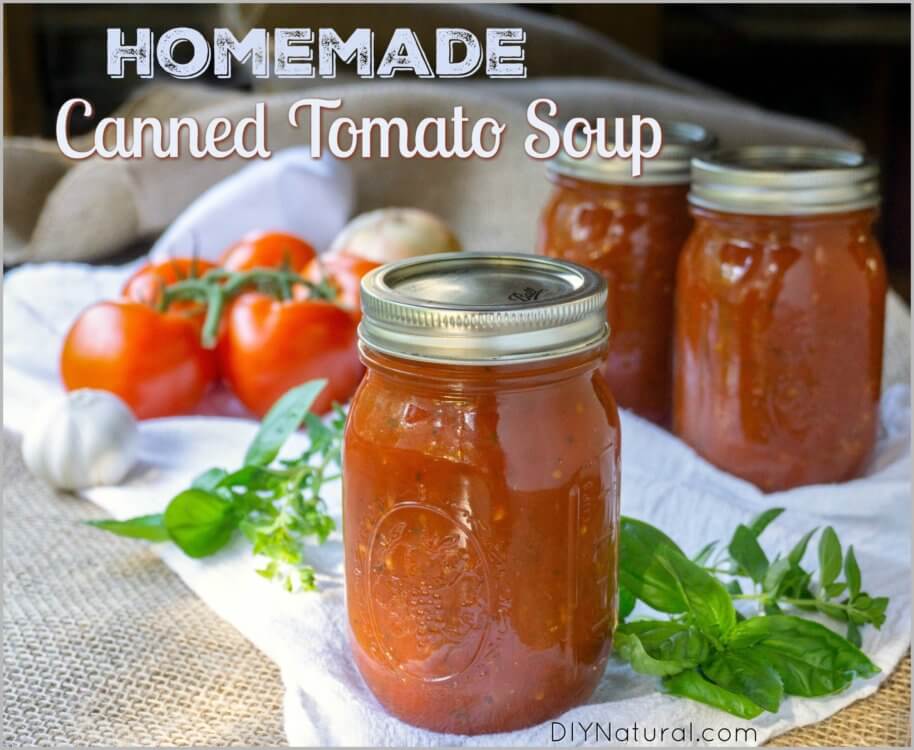

This homemade canned tomato soup recipe is for the folks who loved my previous tomato soup recipe but wanted one that could be canned.
When I shared my husband’s favorite homemade tomato soup recipe a while back, many of you asked if it could be canned.
Unfortunately, making a homemade canned tomato soup is a bit more complicated than throwing any tasty recipe in jars and sending them through the canner. So, I set out to find another tomato soup recipe that my husband would love. This time, it needed to be canning friendly.
Homemade Canned Tomato Soup: A Few Rules
The tricky thing about making canned tomato soup is that many recipes use ingredients like flour as a thickener or cream for added texture and flavor. Neither of these can be safely canned, even with a pressure canner.
The other thing about making it for canning is that you need to use an acid.
When you can tomato soup, you have to make sure the acid level is high enough that it will be shelf-stable. But you also don’t want that acid level to affect the soup.
When canning tomatoes, The National Center for Home Food Preservation advises that you use no more than 3 cups of vegetables for every 22 lbs of tomatoes. If you add too many vegetables, you dilute the natural acid from the tomatoes, and your soup is no longer able to be canned.
Sticking to this advised ratio, I added most of my flavorings for this soup in the way of dried herbs and spices.
How To Make Tomato Soup For Canning
Once you have a good recipe, made for putting in jars, the process is pretty straightforward:
- cook vegetables until very soft
- puree the vegetables
- season the soup
- reduce the soup
- can it!
I used a high powered blender to puree our cooked tomatoes and onion. There were only a few small tomato bits left after blending so I didn’t bother straining my soup.
If you have a blender that doesn’t sufficiently chop up tomato skins, you might want to strain the soup before seasoning and reducing it. Alternatively, use a food mill to puree the tomatoes and get rid of the skins.
What Tomatoes Should I Use?
The best tomatoes to use are “paste” tomatoes. These are tomatoes that have thicker, meatier walls and contain less water.
This means there will be more tomato and less juice, and the soup will thicken up faster, which is important because thickeners can not be used in homemade canned tomato soup.
Probably the most commonly known “paste” tomato is the Roma tomato. These little tomatoes have great flavor and work wonderfully for making homemade tomato soup.
Adding Acid For Canning
As I mentioned, acid is incredibly important in making sure your homemade canned tomato soup will stay shelf-stable.
To really make sure the acid level is right, it is common to add lemon juice or citric acid to the jars when you are canning anything tomato related.
You might be worried that lemon juice would affect the flavor of the soup. It does, but only slightly. And your soup won’t taste lemony at all. Rather, it just tastes slightly brighter.
Citric acid doesn’t alter the flavor of the soup at all. So if you’re concerned about the lemon flavor, use citric acid.
However, there is another factor. When you add milk to the tomato soup that had citric acid in it, the milk separated a little. When added to the soup that had lemon juice, the milk separation was barely noticeable.
I’d rather have a slightly brighter soup with less milk separation. Choose which route is best for your tastes!
Serving Homemade Canned Tomato Soup
Keep in mind that you are making a slightly condensed tomato soup. The finished soup should be slightly thicker than you like to serve it, particularly if you like to add cream or milk to it.
Finally, to serve the canned tomato soup, simply pop open the jar, pour it into a bowl or saucepan, add as much milk or cream as you desire, and reheat.
It’s so easy, and it’s a great way to have a quick lunch or dinner ready in no time. This is the perfect way to preserve your summer tomatoes so you can enjoy them all winter long! (And you skip all the extra salt and additives in the store-bought cans of tomato soup!)
-
Quarter tomatoes and dice the onion. Place them in a large soup pot along with ½ cup of water. Cook, uncovered, for 30 min – 1 hour, stirring occasionally, until tomatoes are very soft.
-
Remove tomatoes from the heat and let them cool slightly. Working in batches, transfer the warm tomatoes to a food processor, blender, or food mill to puree. If desired, press the tomato puree through a fine-mesh sieve to remove any seeds and skins.
-
Pour the smooth tomato puree back into the large soup pot. (Using a very wide-bottomed pot will give you more surface area as you reduce tomatoes, making the process take less time.)
-
Add the tomato paste, sugar, herbs, and spices. (Everything EXCEPT the lemon juice or citric acid.)
-
Bring seasoned tomato puree to a simmer. Cook tomato soup until it has reduced to the thickness you desire. (Mine took 1 hour of simmering.)
-
While the soup is simmering, wash canning jars and keep them warm. Prepare the water bath canner.
-
When the soup has reached the desired thickness, taste it and adjust salt as desired.
-
Add 1 Tbsp of lemon juice to each pint jar or 2 Tbsp lemon juice to each quart jar. (Or ¼ tsp citric acid to each pint and ½ tsp citric acid to each quart.)
-
Fill jars with the soup, leaving ½ inch of headspace. (I like to use a canning funnel to reduce spills and messes.)
-
Wipe the rims clean of any spilled soup. Then cover the jars with the fresh lids and rings.
-
Process your canned tomato soup in a boiling water bath canner for 40 minutes for pints or quarts. (Adjust the processing time as needed for your altitude.)
-
After processing, carefully remove the jars from the water and set them on a cooling rack.
-
Once the jars and soup have cooled, remove the rings and check that your lids have sealed.
-
Finally, return rings to the jars and store the sealed jars in a cool place for up to a year.
-
If any jars didn’t seal properly, refrigerate them immediately and eat within a week.
[embedded content]
The amount of soup you end up with will depend on the type of tomatoes used and how much you reduce the soup. The type of tomatoes used (how much water they contain) will also determine how long the soup needs to cook to reduce down to your preferred consistency.
To Serve
Reheat your canned tomato soup with some milk or cream, as desired.
Serving: 1pint | Calories: 215kcal | Carbohydrates: 48g | Protein: 9g | Fat: 2g | Saturated Fat: 1g | Sodium: 1015mg | Potassium: 2116mg | Fiber: 12g | Sugar: 33g | Vitamin A: 6817IU | Vitamin C: 114mg | Calcium: 137mg | Iron: 4mg
Recipe Video
Tell us what you think in the comments below!
*******
Source: DIY Natural – Food






